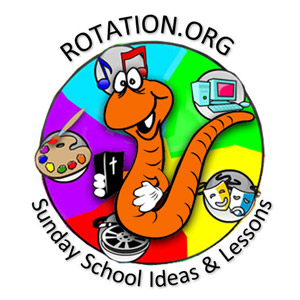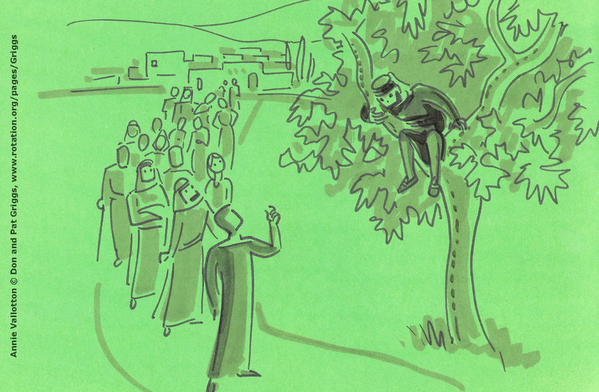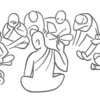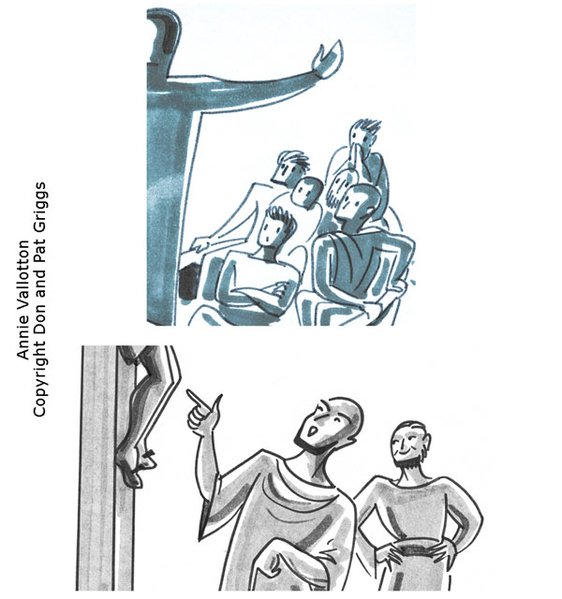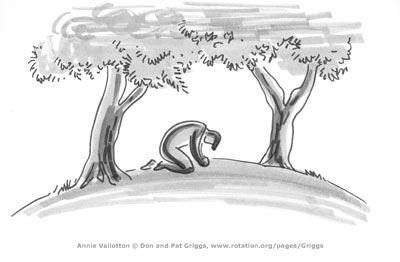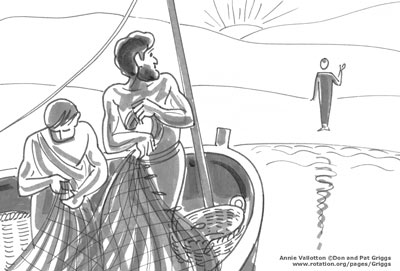EDITORS NOTE: Donald Griggs developed a list of 20 Ways to Use Line Drawings in Teaching the Gospels to be used with Annie Vallotton's illustrations in the Good News Bible. He has adapted that list for use with the Annie Vallotton Bible Illustrations Collection housed here at Rotation.org. He shares a variety of activities that are appropriate for children, youth, and adults.

Using Line Drawings to Teach the Gospels
by Donald L. Griggs
Introduction
In the 1960s the American Bible Society published a new translation of the Bible, The Today’s English Version (commonly known as The Good New Bible) which included several hundred line drawings created by artist Annie Vallotton.
In 1973, I published Translating the Good News Through Teaching Activities in order to offer a wide variety of suggestions for teaching with the Good News Bible. My book has long been out of print, but much of what I wrote is as useful today as it was in 1973. Many of the following suggestions are gleaned from that book.
We live in a time when smart phones, iPads, and laptop computers dominate our communication and education experiences. It may seem counter-productive to be focusing on such an old-school medium of colorful line drawings. However, I believe there is much to be gained by engaging participants of all ages in activities that feature these simple, beautiful artistic renderings of biblical narratives. In addition, it is possible to use the digital images on our computers, iPads, and smartphones. I am sure that your own imagination and creativity will lead you to expand on the suggestions that follow.
Preparing to Use the Line Drawings
Download line drawings to create your own scripture cards. One suggestion is to use a word processing application to create any number of pages with eight images per page. You can print them on photo paper or presentation paper and cut them out so that you have a collection of scripture cards for the Bible story (or stories) of your choosing.
Many of the suggestions that follow describe activities for using the cards you have created. In addition to creating smaller cards it is possible to produce a set of larger drawings on full size sheets of photo or presentation paper. These larger images will be useful in a variety of activities.
We created a script to accompany each of the sets of line drawings. (The scripts appear as captions with the full-sized color images.) You could prepare the scripture cards with the colorful image on one side and the Bible passage related to the image on the other side. Having the Bible passages will be helpful for several of the activities that follow.
One: Have Fun with the Line Drawings
Divide the class into small groups and give to each group a pack of cards. Instruct the participants to spend five minutes looking at them and trying to decide if they can think of any Bible stories that might be illustrated by one or more of the cards. Invite the participants to share several of their suggestions of which line drawings illustrate which Bible stories.
Ask each participant to select her or his favorite card and share with others in the small group why that is their favorite.
Two: Organize Cards into Categories
There are several ways to motivate the participants to classify the cards into several categories:
1. Give each pair of participants a pack of cards and instruct them to sort the cards into as many different categories as they can think of. You will be surprised by the variety of categories the participants discover. Then share the suggestions with the larger group.
2. Invite pairs of participants to put all the cards into two stacks; the ones representing Bible stories they recognize and the ones that are unfamiliar. This would be a good informal pre-testing technique for leaders to discover what Bible stories are remembered by the participants. It is likely some will associate a particular line drawing with a Bible passage different from the one that was intended by the artist.
3. The teacher could preselect a topic (such as parables or miracles of Jesus) and direct participants to identify cards that they think might be associated with the topic. After choosing their cards the participants can be invited to share with one another how the images they chose related to the topic.
Three: Incorporate Line Drawings in a Workshop Rotation Model Lesson
- Consider the suggestions in Activities Four and Five as a way to use scripture cards in a Bible Games workshop.
- Activities Eight and Fourteen offer some ideas for using the lines drawings in an Art Workshop.
- Look at Activities Nine and Sixteen to see some ways the line drawings could be used in a Drama Workshop.
- Activity Eleven provides an example of how a teacher could prepare an Instructional worksheet for use in a Bible Skills Workshop.
- A Computer Workshop is a natural for featuring the line drawings. The teacher save a series of digital images in a folder on the computer hard drive for the participants to access. Individually or in pairs the workshop participants can be directed to do one or more of the following:
- Arrange the images in a chronological sequence.
- Select six to ten images, arrange them to tell a story, and write a brief script for each image.
- View the images of one of the four sets of line drawings and listen to the script of Bible passages that accompanies the images.
- The questions in Activity Eleven could be adapted for use on a computer.
Four: Arrange the Cards in Chronological Order
Select a dozen or more images that clearly represent events in the life of Jesus and his followers. Invite the participants in pairs or threes to arrange the selected images in an order that they think tells a story about Jesus and his followers. Provide about fifteen minutes for the task and then invite the participants as a larger group to walk from table to table to view each small group’s story line. It is likely that no two story lines will be the same, which provides an opportunity to explain that in the four Gospels the story lines are different as well.
Five: Play Games with the Scripture Cards
Familiar games like Concentration, Go Fish, Categories, and many other games may provide models that can be used to create a game to play using the scripture cards. Creative teachers and leaders can use their imaginations to create new games that will provide enjoyment in playing them as well as an opportunity to enhance the learning of the participants.
Six: Use to Motivate Creative Writing
1. Invite participants to select one scripture card and do the following:
- Find the scripture passage associated with the line drawing.
- Read the full narrative of the passage.
- Give the line drawing a title or heading.
- Create a dialogue between the characters represented in the image by writing a short script.
2. Focus on the scripture passage represented by the line drawing and paraphrase it.
3. Use the line drawing and the scripture passage as the focus for creating a poem. The poem could be in free verse or could use the structure of cinquain or haiku poetry.
4. Some participants will have musical talent that they could employ to create an original song with notes and lyrics or write new words to a familiar hymn tune.
Seven: Use Line Drawings to Stimulate Memorization
Even though straight memorization is not necessarily a “fun” activity there may be times when teachers want to be sure the participants remember particular passages. The scripture cards can provide a fun way to motivate learners to memorize passages associated with particular cards.
Eight: Compare with Other Works of Art
Many of the line drawings illustrate familiar Bible passages that have been the subjects of artistic expressions over the centuries. Select one line drawing and then search the Internet for free downloadable artistic renderings of the same passage. Print or project the line drawing and two or three other pieces of art related to the same passage. The teacher could guide a discussion with questions:
- Which of the artistic expressions is your favorite? Why?
- What do you think the artists were trying to communicate through their paintings?
- What feelings are communicated to you through each of these works of art?
- Think of a question you would like to ask the artist if he/she were here.
Nine: Use as a Starter for Informal Dramatization
1. Divide the participants into two teams to play charades. Give each team a different set of cards. Members of each team take turns presenting the message of the card to see if the other team can guess the passage they are trying to present.
2. All the line drawings represent events in the lives of Jesus and his disciples. Small groups could select one or more of the cards to use as the basis for developing a creative drama to express the actions, feelings, and message of the events.
3. Just by looking at the drawing on a scripture card it is possible to imagine a situation of conflict, decision-making, or personal encounter. The participants could identify with the situation in their own creative way and with one or two other persons develop a role play of the situation.
Ten: Add Scripture Cards to Worship Bags
Many churches provide worship bags for children to use during worship. A scripture card with line drawing on one side and the Gospel passage on the other side related to a biblical text for the sermon could be added to the worship bag along with a brief message that includes some questions to think about.
Eleven: Line Drawings as Part of an Instructional Worksheet
There are times when a teacher-prepared instructional worksheet is an appropriate resource to engage the learners. This may be especially true if the teacher has planned several activities from which the participants may choose to be their focus for the session. The participants could work alone, with a partner, or in a small group to complete the tasks outlined in the worksheet. On the front side of the worksheet will be the instructions and on the back side will be a number of line drawings.
Possible worksheet activities:
- Look at each drawing to decide which Gospel passage the line drawing illustrates. Give each image a title.
- If you have trouble identifying any of the pictures refer to the given passages. (List scripture passages for the drawings in random order.)
- Select one or two line drawings to be your focus. Look at the drawing and read the passage. Then, decide on a way to express your understanding of the meaning of the passage. You could write your own interpretation, illustrate with creative materials, or act it out with a puppet.
- Read these related passages (for Bible stories in more than one Gospel).
- Create your own line drawing to illustrate this passage.
See a sample "Peter and Jesus" worksheet here.
Twelve: What Questions Do You Have?
Select one of the line drawing images to use for motivating the participants to state their own questions. Look at the image as the teacher or a participant reads the passage associated with the line drawing. Give the participants a minute or two to think of a question or two they have about the passage. After the learners have had time to think of a question, the teacher invites the participants to share their questions. It is important to write the questions down on a sheet of newsprint or on a white board so everyone can see the questions. After creating a list of questions spend some time discussing them. Help the participants to realize that you aren’t looking for right answers, but rather you are looking for their ideas and interpretations.
Thirteen: Matching Images with Biblical Texts
This activity requires two sets of cards; one set shows the line drawings and the other set displays the scripture text. Produce sets of ten to fifteen cards each. Lay out all the line drawings on one side of the table and all the biblical text cards on the other side. The task is to match up the line drawings with their related texts. The participants can work individually or in pairs to do the matching. The game could become a little competitive if you want to see which pair can do the matching the quickest.
Fourteen: Create a Montage to Illustrate a Key Concept
Begin by directing each pair of participants to select one line drawing. They are to then place the line drawing in the middle of a large sheet of construction paper or sheet of butcher paper. Provide each pair with several old magazines that contain a lot of photos. After reading the passage associated with the line drawing, the pairs are to state what they understand as the key concept or meaning of the passage. Then, they are to select photos, headlines, key words, or ads that they think emphasize a similar concept as the scripture card. They mount the photos, headlines, words, and ads they have chosen around the scripture card on the sheet of paper. After all have completed their montages each pair shares their creation with brief comments to explain why they chose what they did to illustrate the line drawing and the passage it portrays.
Fifteen: Images as Background for Scripture Reading
Select one to three line drawings as the focus for a brief devotional during the class session. Print or project each image where they can be seen during the devotional time. The teacher and/or participants can select a hymn or two that communicates the same theme as the line drawings. One or more members of the group will read the passage(s) associated with the line drawing(s). Or, the passage(s) could be duplicated in order for the participants to read the passage(s) in unison.
Sixteen: Use Line Drawings as Story Starters
After the class has studied a particular Gospel narrative the teacher can select one or more line drawings associated with the narrative and lead the members in a process of story-telling. Display the selected line drawings. Invite the participants individually or in pairs to create a story incorporating what they remember about the particular Gospel narrative followed by adding their own creative ideas of what happened next or by introducing new material to enhance the Gospel passage. Be sure to provide time for sharing after the creativity.
Seventeen: Use Cards to Divide a Large Group into Small Groups
Ahead of time, determine how many persons will be in each small group. Estimate how many are expected to attend the gathering. Select enough images for the number of groups you need and print the number of copies of each image as you want persons in each group. As persons arrive give them a card. After everyone has arrived direct everyone to search for the other persons with the same card, thus forming the small groups.
Eighteen: Create a PowerPoint Slide Show with Narration
PowerPoint has become a very popular computer program for making visual presentations. The digital images you download are perfect for dragging and dropping into a PowerPoint presentation. The presentation could be a slide show of one of the four sets with the script either recorded to accompany the slides or typed onto a blank slide following the images. Another option would be for a team of two or three learners to create the PowerPoint presentation. This could be an activity in the Computer Lab of the Workshop Rotation program or completed at home by a participant that is motivated to accomplish this.
Nineteen: Encourage Interaction in Small Groups
This activity may be best illustrated by an experience I had using Scripture Cards in a workshop I conducted in a small church on the Hawaiian Island of Molokai.
The Hawaii Council of Churches and the Hawaii Diocese of the Roman Catholic Church invited me to conduct two weeks of workshops for church teachers on all five islands. I had never been to Hawaii so the whole adventure was a new experience. At each venue I was treated with exceptional hospitality. One memorable experience was on the island of Molokai. I was scheduled to lead just one workshop on a weekday night. My host, Mrs. Hasagawa, took me to the only church in town where I would conduct the workshop, to meet the pastor and his wife who hosted me for dinner. He was a recent graduate from Andover Newton Theological Seminary, a graduate school of the United Church of Christ. During the meal he shared several bits of information to help me know what to expect. He said that I shouldn’t expect many participants since there were only about a dozen Sunday school teachers on the whole island. And, he advised that they had never experienced a workshop and usually when visiting pastors come from the Mainland they just preach. Don’t expect those who attend to participate verbally. I told him that I wasn’t planning on preaching, that it didn’t matter how many people showed up, I would be flexible and go with the flow, and would do what I was comfortable doing.
You can imagine my surprise (and the surprise of the pastor) when about 40 persons showed up for the workshop. We kept adding chairs. In my introduction I asked persons who were Sunday school teachers to raise their hands and eight or ten raised their hands. Then I asked, “How many of you are parents or grandparents?” Everyone raised their hands and I responded, “This workshop is for all of you who want to share the good news of Jesus with your children whether at home or at church.” Then I was bold to ask, “I’m curious. Since this was advertised as a workshop for Sunday school teachers, why have all of you chosen to come?” A brave soul in the group responded, “Today there are no deaths, births, or weddings on the island. This is the only thing happening tonight so we decided to check it out.”
After some introductory remarks and a participatory opening prayer, I led them in the first activity, wondering if the pastor’s warning would turn out to be true. I asked them to form little groups with four or five in a group. Then I distributed a pack of Scripture Cards to each group. I asked them to share the cards among themselves to become familiar with the Bible stories each card represented. After a few minutes of getting acquainted with the cards I asked that each person select one card that reminded them of a favorite Bible story. When each person had chosen their card, I asked them to share with the others in their small group why they chose the card they did. What followed was an amazing chatter of sharing that filled the room with energy. I had a hard time interrupting their sharing and when I did get their attention, I told them they could keep the card they had chosen. I realized at that moment the participants were truly engaged and I could do just about anything in the next hour or so. We focused primarily on storytelling, which, of course, is a natural part of their culture. I did not have a conversation with the pastor afterwards. I would love to know what he thought of the evening’s event.
Twenty: Many Other Ways
Here are some “ticklers” to spark your imagination and creativity as you consider more ways to use the line drawings/scripture cards:
- Make a hanging mobile.
- Use in worship to focus silent meditation.
- Give cards to class members after they can retell the story in their own words.
- Which person in the drawing would you like to be? Why?
- Use to decorate a room.
- Create a tableau of the same event.
- Use as basis for woodblock, linoleum print, embroidery, or stitchery.
- And, whatever other activities you can think of. Post your ideas and adaptations below!

 Share your suggestions for using the Annie Vallotton Bible Illustrations by posting a reply below. And look for additional ideas in the individual workshop technique forums.
Share your suggestions for using the Annie Vallotton Bible Illustrations by posting a reply below. And look for additional ideas in the individual workshop technique forums.